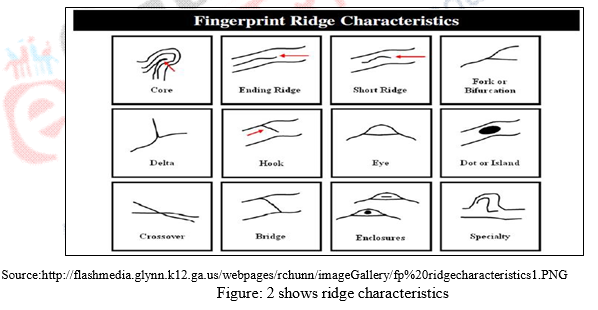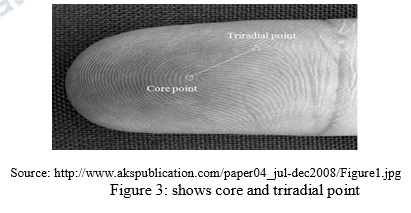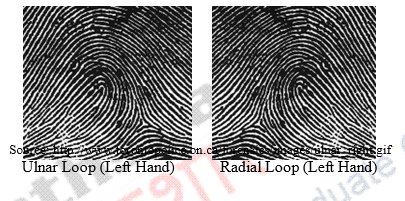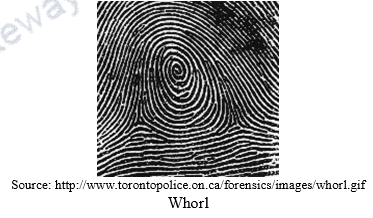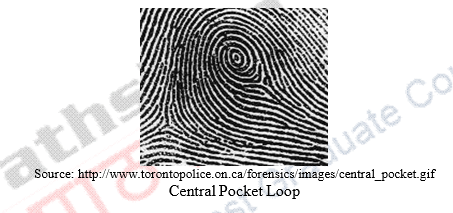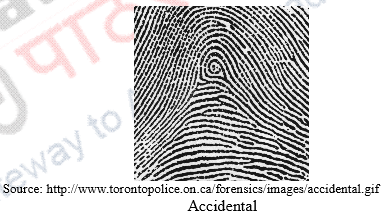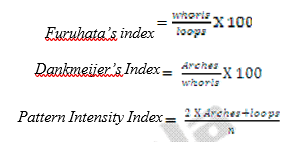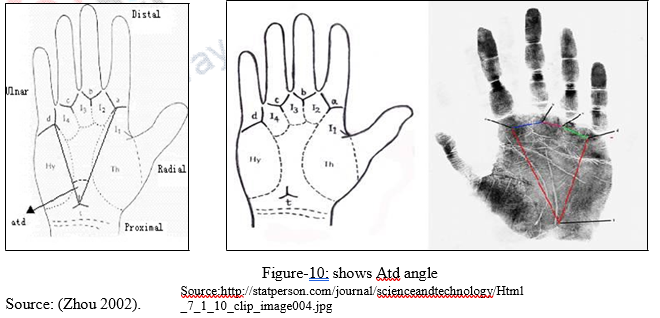19 Analysis of Palm and Fingerprints
Introduction
Analysing process is careful examination of the print and identification of various patterns, sub- patterns, minutiae or ridge characteristics established on the print and then the comparison is made between prints on the basis of those patterns encountered. If the patterns of both the prints are identical, then we proceed for further comparison in terms of ridge details and after analysing we are able to reveal the result that the print belongs to the same individual. Thus Analysis extracts the physical features of a print that can discriminate an individual from the other. And for this purpose it is necessary to understand the characteristic feature of the palm and fingerprints. Ridge counting, ridge tracing and various other techniques are employed to successfully analyze fingerprints.
The palmar and plantar surfaces of human hand and foot differ from the covering that entails the rest of the body parts in terms of skin surface. The skin here is devoid of hairs and sebaceous (oil) glands but sweat glands are numerous and abundant and is entirely corrugated with narrow ridges. These ridges form definite patterns on the fingers or palm and proper classification or analysis of these patterns helps us to differentiate between prints. The high variability in the details of ridges, in presence or absence of definite patterns and in the type of patterns helps individualize a person. It is said that no two persons can have exactly same prints even in the case of monozygotic twins within a cube of 4 nm of print. This is the reason behind its wider application in various domain of studies such as in personal identification and thus aids in forensic science in legal setting to reveal criminals, twin studies, studies of inheritance, studies of racial classification, and in many other studies of biological aspect. It is very important now to understand how to differentiate between prints or in other words how to analyse a print and for this purpose we need to know the characteristics or patterns of ridges in prints of palm and fingers.
2. Characteristic features of the fingerprints:
2.1 Ridges
Ridges are elevated ribbing of the surface, separated by grooves called sulci. Ridged skin along with palmar and plantar surfaces also occurs over the tips of the fingers. Ridges present numerous characteristics such as branching, interruptions and irregularities. Such characters are collectively termed as minutiae or ridge characteristics. Along the side of the ridge runs single row of sweat gland ducts spaced at regular intervals. The distance between successive sweat pores on a ridge are about equal to the width of the ridge. Nowadays, various studies have been carried out on sweat pores as the variation they embrace in a unit area in terms of their pattern of distribution, the spacing between successive pores, alignment with reference to the axis of the ridge are sufficient to establish identification of an individual.
2.2 Ridge Characteristics:
The ridges form definite patterns or designs on the terminal segments of fingers and in palm and soles. These ridge patterns can be classified according to their general construction. Individual ridges show various irregularities of direction, discontinuities and branching. Such characters are collectively termed as minutiae or ridge characteristics. There are various types of ridge characteristics:
Incipient, rudimentary or nascent ridges:
These are not usually grouped among minutiae, but have a logical place in consideration of ridge characteristics. Incipient ridges are very narrow, frequently interrupted and lie in the sulci. Nascent ridges lack pores, a feature that distinguished it from the typical ridges.
· Islands:
The ridges frequently show transverse constrictions suggesting segmentation into units, each unit being associated with one sweet pore. These individual segments are sometimes completely disjoined and termed as islands. When two, three or several such ridge units, are consolidated then they are designated as short ridges.
· Ridge Ending or End or termination:
End or termination can be understood as an abrupt stop in the course of ridge.
· Bifurcation or fork:
A ridge may branch forming a bifurcation or fork like structure. Bifurcation is based on the consideration of one ridge branching rather than two ridge joining. If the two ridges were considered as coursing from the opposite direction they are described as fusing instead of bifurcation.
· Eyelet or enclosure or lake:
Eyelet or enclosure may be described as rejoining of two branches after a short course.
· Cross-over:
Point of intersection of two ridges.
· Hook (Spur):
One short ridge branching from a long ridge.
· Bridge:
A short connecting ridge between two parallel running ridges.
2.3 Fixed points in fingerprints:
- Point of Core:
Core is a pivotal feature in the interior of the pattern. The core may appear as a dot, an island, a short straight ridge, a rod, a circle or ellipse, a two interlocked hook shaped ridge or staple. It is not the core as a whole but the point of core is a landmark for ridge counting. The point of core is a centrally located core element. In case of a single rod core, the distal tip of the rod is the point of core, with uneven number of rod in core, it is the tip of the central one and with even number the central pair is treated as two rod core. In case of hooked shaped ridge, the point of core lies at the junction with the distal recurvature of the staple.
- Triradial Point:
Triradial point or triradius is located at the meeting point of three opposing ridge systems. A triradius is often described as a delta but a distinction can be made between them. A delta is a triangular plot whereas a triradius is represented by ridges forming its boundary. Thus a triradius may be present if there is no true delta. The triradius has immense importance in finger print analysis. First, the three ridges extended from the triradius become the three radiants. Second, the ridges extended from triradial point as type lines (lines traced on the prints as solid lines for emphasis) constitute the skeletal framework for print analysis. Third, Triradius provides a landmark as triradial point for ridge counting and tracing which ultimately forms the outer terminus of the line along which ridges are counted.
2.4 Some fundamentals of fingerprints:
- Pattern area:
The area enclosed by the type lines by tracing the ridges extended from the triradius is denoted as pattern area. The pattern area represents only a section of the whole fingerprint. The region distal to the pattern area is the distal transverse system and the region proximal to the pattern area is proximal transverse system.
- Radiants:
The three rays traced on the print from the triradius by following the ridges are the three radiants. The three radiants are named according to their relation with the finger and with the pattern. The one passing through the digital border is the marginal radiant, the one in the marginal and distal relation to the pattern area is the distal pattern radiant and the one in the proximal relation to the pattern area is the proximal pattern radiant.
2.5 Basic types of patterns in fingerprints:
Galton classified three basic types of ridge patterns – Arches, Loops and Whorls. But in the Henry system of classification there are four main types of patterns: Arches, Loops, Whorls and Composites.
Arch:
The arch is the simplest of all fingerprint patterns. It is usually designated as pattern but arch is actually patternless. In arch, ridges pass from one margin of the finger to the other with a slight bow distally. There is no triradius and the three radiants are not distinguishable. This type is designated as plain arch. Arch can also form a tent like structure because of elevation of transversely coursing ridges defined as tented arch which possess triradius located in or near the mid axis of the digit.
Loop:
The loop is simpler in construction as compare to the whorl. It comprises only one triradius. Thus the ridges curve around only one extremity of the pattern and from the opposite extremity, ridges flows towards the margin of the finger; thus this extremity of the pattern may be described as open. If the loops open towards the ulnar side of the finger, it is referred as ulnar loop whereas if it opens to the radial side, it is called radial loop. Loops may also be classified according to the size determined by the ridge count and according to the placing of the core with reference to the triradius. Thus, it can be narrow or broad loop, erect in line with the digital axis, or aligned obliquely or transversely to the digital axis.
Whorls:
The typical whorl has a generalized pattern which may be used as a standard of reference. It possesses two triradii and is distinguished by concentric pattern of ridges. The characteristic ridges form complete circuit around the core. Thus whorl is a succession of rings or ellipses or spiral course which is either in clockwise direction or in anti clockwise direction. The periphery of the whorl determines the shape of the pattern area which may be either circular or elliptical and there are wide differences in the expanse of pattern area of whorls. In whorls, the three topological zones or radiants are well defined and distinguished.
Composites:
Composite represents the heterogeneous assemblage of patterns. These are compound patterns in which two or more basic patterns are combined in one pattern area. For example, a whorl and an ulnar loop, present in a finger tip or in a pattern area, form composites. In composite pattern, two or more triradii are present. Basically there are four main types of composites encountered: central pocket loop, lateral pocket loop, twin loops, and accidentals.
- Central pocket loop: A central pocket is a pattern intermediate between a whorl and a loop. In this whorl of reduced size, lying in the interior of the pattern, like a core and then the ridges flows towards the margin of the finger. Thus central pockets can be classified as ulnar or radial according to the direction of the open extremity of the loop.
- Lateral pocket loops: A lateral pocket loops are composite type bearing two interlocked loops and thus there are two cores. When lines traced from the two cores emerge on the same digital margin such as radial or ulnar, the pattern is a lateral pocket loop.
- Twin loops: Twin loops and lateral pocket loops are closely similar structures as both are composed of interlocked loops. Thus the distinction between them is of importance in the domain of identification and analysis of print. They differ in terms of coursing of ridges from the core of the two loops. When the two lines course to opposite direction one in ulnar margin and the other in radial margin, it becomes a twin loop.
- Accidentals: Accidentals are complex patterns, formed by combination of two or more unrelated patterns types such as a whorl and a loop, a tented arch and a loop, triple loops or any other patterns not assignable to the standard types.
3. Analysis of fingerprints:
- Identifying a particular Pattern: Fingerprints are analyzed by using magnifying glass and a pointed pencil. Delicate uniqueness in terms of patterns of the print is recorded.
- Ridge counting: Ridge Counting is performed to analyze a fingerprint: Ridge counting is defined as the number of ridges crossing or touching an imaginary line drawn between point of core and the triradius.
Rules for ridge counting:
- Point of core and triradius are not included in the count.
- If the imaginary line passes through the bifurcation, a ridge count of two is made at that point.
- If the imaginary line passes through an enclosure, a ridge count of two is made at that point.
- If the imaginary line touches a dot, a ridge count of one is made at that point.
- Pattern type indices:
Pattern type indices are calculated on the basis of frequency distribution of the various finger patterns. There are three indices: Furuhata index, Dankmeijer index and Pattern intensity index. These indices are useful in the interpretation of fingerprint data and analyses of quantitative results as it depicts the reciprocal relationship between loops, arches and whorls.
· Patternintensity:
Patterns form a sequence of increasing pattern complexity which is expressed by counting the number of triradius present. According to the number of triradius, a finger can have a pattern intensity of zero to three. In case of arch which lacks triradius, number 0 is assigned, the tented arch and the loop both are assigned number 1 as each has one triradius.
- Pattern size: Pattern size is determined by the ridge count from triradial point to the point of core. It is useful in inheritance studies. Pattern size is recorded as two integers representing the ridges counts, one for that of the radial side of the pattern and one for the ulnar side. Thus in an ulnar loop it may be represented as 8-0 where as for the radial loop the reverse notation as 0-8. For the whorls it will be like 4-8.
- Pattern form: Fingerprints can be analyzed in terms of pattern form as same patterns are variable with respect to the form of pattern area. Some patterns are elongated in the axis of the finger whereas some are broad. Many a times, index of pattern form was generated which indicates ratio of breadth to height of a pattern. Those prints intended for measurements of pattern form should be taken with caution and the pressure should be even and gentle throughout the print as breadth increases with added pressure.
4. Characteristic features of palm print:
The configuration of the palmar area is classifiable according to the general principles which govern the classification of fingerprints. In palm prints, to denote the location of various features proximal, ulnar, distal, and radial are frequently used notations. Palmar surface is divisible into six topological units or configuration areas: hypothenar, thenar and the four interdigitals areas which are formulated individually. Each configuration area of the palm is recorded as a descriptive symbol which forms pattern formula in this order: Hypothenar, thenar/ interdigital I, interdigital II, interdigital III, interdigital IV. Palm area is interrupted by flexion creases which serve as a landmark in descriptive dermatoglyphics but they are not the components of dermatoglyphics. Flexion creases are the lines of the palm. It represents the location of the attachment of the skin to the underlying structure. These are termed as white lines when viewed in prints. Major flexion creases across the palm are bracelet creases, metacarpo-phalangeal creases, radial longitudinal creases, distal transverse creases and proximal transverse crease.
In palms, triradii are distinguished in term of their location as digital triradii and axial triradii. Characteristically there are four digital triradii located at the base of digits II, III IV, and V in proximal relation. They are named as a, b, c and d in radio-ulnar sequence. The four main lines originating from digital triradii are A, B, C and D in radio-ulnar sequence. Axial triradiit is located at the proximal margin of the palm. A palm may have one, two or three triradii or rarely none. Formulation of axial triradii in main line formula is separated from the succeeding pattern formula by dashes. The most distally situated axial triradius near the centre of the palm is t’’ and the one lies in the intermediate level is t’. In the absence of triradius symbol 0 is used.
Palm area can possess any pattern or configuration like fingerprints such as whorl, loop, and arches. As compared to fingerprint whorls, palm print whorls have three triradii instead of two. The symbol for the whorl is W. However we add s as a superscript for whorls presenting spiral or double- looped centres (WS). For whorls having eight or less than eight ridges from the core to the nearest triradial point, we formulate the whorl as small by using the symbol w instead of W.
Palm print loops differ from the fingerprint loops in terms of direction of opening. A fingerprint loop has two directions while a palm print loop has three: ulnar side, radial side and carpal side or proximal side. The symbol for loops is L and superscript are added for the direction of opening such as Lu, Lr,Lc. Loops with eight or less than eight ridges are formulated as l. Arches is designated by A with Au , Ar, Acfor ulnar, radial and carpal direction respectively. Likewise for tented arch as Tu, Tr, and Tc. Open fields in which ridges are straight instead of arch are designated O and vestiges as V.
In case, a configuration or palmar area bears two true patterns such as two ulnar loops. Then it is formulated with two discrete configurations, separated by a slant and the distal configuration being recorded first e.g. Lu / Lu. Complex configurations not assignable to the any of the types above characterized as Y.
5. Analysis of palm print:
Formulation of main- line formula:
A main line is traced according to the same rules as type lines in fingerprints. Main lines A, B, C and D originate from the respective digital triradii and line T from the axial triradii. In case of multiple axial triradii, line T is traced from the proximal one. The formulation of main line is based upon the number sequence of positions around the periphery of the palm. The number sequence begins with the proximal part of the thenar eminence and continues around the ulnar, distal and radial borders of the palm. Numbers are applied to a series of 14 intervals and points. Each traced line is described by the position in which it terminates. Suppose a line terminating in the second interdigital interval, it will be formulated by the number of that interval. After tracing the main lines, main line formula is formulated and it composed of the symbols of terminations of lines, recorded in the order D, C, B, A and T followed by the respective patterns. Main lines termination, patterns in different configuration areas like hypothenar, thenar and interdigital areas, formulation of patterns and special formulations all aid in the analysis of uniqueness of a palm print.
Main-line index:
Main-line index is the sum of the two numbers corresponding to the termination of main lines A and D. The main-line formula serves as an indication of the direction of palmar ridges. The termini of two of the main lines, A and D are observed and the sums of those numbers are denoted as main- line index. This will give an idea of palmar ridge transversality which may be of clinical significance. A low value for the index indicates vertical ridge alignment, whereas a high value reflects a tendency for the palmar ridge to be horizontal.
Ridge counts:
Ridge counting in palm is done according to the same principle applied in counting fingerprint ridges. The only difference is ridges of the palm are counted between two digital triradius. Counting is done by connecting both triradius with a straight line and the count excludes the ridge forming triradius. Ridge count between triradii a and b referred as a-b ridge count which is most frequently used dermatoglyphic analysis particularly for medical purposes, count between b and c referred as b-c ridge count whereas count between c and d referred as c–d ridge count
Pattern intensity:
The pattern intensity of the palm can be expressed as the sum of all triradius present.
‘Atd’ angle:
The most widely used method for analysis of palm print is ‘atd’ angle. This angle is formed at the axial triradius t. The more distal the position of axial triradii t in the palm, the larger the atd angle. atd angle is drawn from the digital triradius a to the axial triradius t, and from the axial triradius to the digital triradius d.
Summary:
In a nutshell it can be said that the true basis for analysis of fingerprints or palm prints is the comparison of their individual ridge characteristics. Analysis extracts the physical features of a print that can discriminate an individual from the other. Analysis of palm and fingerprint is helpful in personal identification, twin studies, studies of inheritance, studies of racial classification, and in many other studies of biological aspect. Now a day’s various automated techniques are employed to analyze the fingerprint and palm print which requires pre-processing of image of print then extraction of patterns or features is performed and after that verification is done. But the basis for analyzing the prints lies in the understanding of the features of the print.
| you can view video on Analysis of palm and finger prints |


